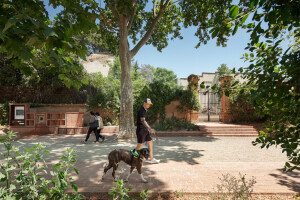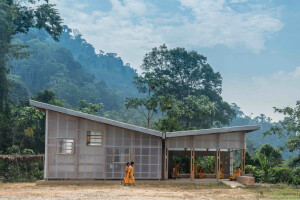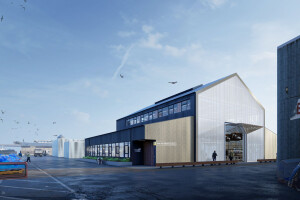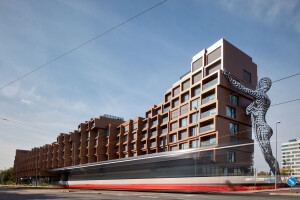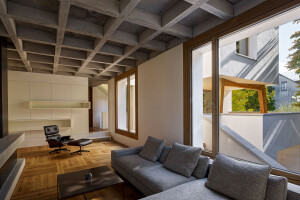In a suburban residential area, located at the edge between the periphery and the urban tissue of Palma, we are asked to propose a Day Center and Community Activities for a small budget: 620€/m2. The proposal is based on three basic principles:
1. COLLECTIVE AREAS We understand the project as an opportunity to enhance relations and collective activities between the users. Therefore, the building is arranged around a large and sunny private garden with two existing pine trees, sheltered from the wind and protected from pedestrians' and neighbours' views. The garden articulates all the Day Center activities.
2. CHARACTER We propose the consolidation of the Center’s institutional character as the articulator of the public area by the building’s image without using the monumentality. Therefore, we use a unique colour for the different façade materials and a local stone (already used on some public spaces around the area) in order to establish a clear and identifiable public identity. The building cedes a three-meter wide strip to the public space, providing a relational area around the building before entering.
3. RESOURCES Due the economic budget constraint of 620 €/m2, we propose to use the bricollage as a technique that allows us to give a hybrid answer, combining local (artisan) with global (industrial) techniques and materials in order to optimize the resources offered by both sectors. Architectural form is used here as a strategy for sustainability emphasizing passive strategies.
In short, we are interested in the ability of any project to give a meaning within a specific cultural context using an unprejudiced attitude allowing us to find opportunities even in the apparent worthless. We propose using particular cultural contexts as opportunities from which to build the project’s strategy. We choose an inclusive and unprejudiced attitude that don’t discriminate neither this nor that, but opts for this and that.
TOPOGRAPHY: The plot has a slope of 250cm between its ends on the main façade and a high density soil. For accessibility reasons, we decided to develop the project in one floor and set the implantation level at the midpoint between the two levels of the ends of the site, this way, land which is dug at one end is repositioned on the other. Thus minimizing unnecessary earthmoving and avoiding the high cost the displacement of soil to the dump has in Mallorca. Besides, the project wins in thermal inertia (as required in the Mediterranean climate) and intensifies the user's relationship with the vegetation in the perimeter, by being placed at the user’s eyes level.
VEGETATION: The plot has a series of pine trees, olive trees, a carob tree and low bushes. We decided to keep healthy pines (two units in courtyard) and the carob tree (in setback area) and adjust the boundaries of the building respecting their bulb roots. We decided to transplant the wild olive trees (12 units) to replant them in the setback area after the work. It was decided that the remaining vegetation to place (local shrubs: bush, rosemary, lavender and ivy) will have to coexist with the vegetation that grows spontaneously, allowing, this way, the natural development typical of the "Majorcan garriga". This is then, once again, to work for and not against available resources, always understanding the precedent as an opportunity from which to develop the project.
STRUCTURE: The formal outcome of the project is a direct consequence of the structural definition. The structure consists of a mixed slab (unidirectional slab in the areas with suspended ceiling and exposed concrete slab the rest) with downstand beam around the perimeter, (which acts as a lintel and minimizes the amount of reinforcement to use) supported by pillars in concrete, metal or loading wall, depending on its location, all this to optimize the cost of the intervention.
All reinforced concrete is formworked with board and, in the exterior areas, is coated with white anticarbonation paint due to the low concentration of cement in the concrete, which allows a considerable reduction of the cost of concrete. In street façade, given the big amount of repairs to be made due to a defective formwork and vibrating, we decide to coat the concrete with a projected mortar "esquitxat" characteristic of the island and paint it white like the rest of the elements of the facade. This is, again, to work for and not against the problems that may arise on site.
CLOSINGS, PARTITIONS AND CLADDING: In order to avoid unnecessary discards of OSB panels that define the division between collective areas and offices, the Center's free height fits the OSB standard panels’ dimensions. Climalit double glazing (3 +3/6/4 +4) is sized so you never exceed 2.5 m2, which is considered the threshold at which the cost increases significantly. Both the terrazzo floor and the wall tiles in the bathrooms are executed with materials produced in the island since its zero cost transport. The surface of white painted galvanized expanded steel lattice (which comes from a remaining of a warehouse on the island), is minimized, and strictly adapted to the surface of windows to the street. Its diamond shaped drilling is placed vertically to avoid east and west solar radiation, as well as to control the interior-exterior visual relationship.
SUPPLIES: All the supplies are exposed, reducing by 80% the cost of the "aids work", except for the areas where the construction in dry allows their passage in its extrados (suspended ceilings and OSB panels). In the collective areas, defined by the exposed concrete slab, we take advantage of "h" tube that gives supply to the lamps, as an ornamental opportunity that helps qualifying the interior.
GARDEN: In order to minimize the economic investment in the pergola, we decided to work with geometry as an ally. Inverted triangles allow, on the one hand, to stabilize the frames without complex rigid nodes, allowing a reduction of the steel profile section (IPN80) and its weight, and on the other, to minimize the number of concrete foundations to be performed. The bamboo, a very cheap, lightweight, easily replaceable and locally manufactured material, will confer certain atmosphere quality and ensure sunscreen to south, east and west.
The garden containment of lands is also made by geometry. The high cohesion of the soil enables, by maintaining the minimum required angle and complemented by a low inclined wall of local stone (marés), to guarantee the land doesn’t slide. The piece of marés, due to its low cost, its visual quality and its roots in the collective memory is also used to solve the construction of the continuous bank that runs around the perimeter of the building in contact with the road and, at the same time, contains the land in the parterre.





















